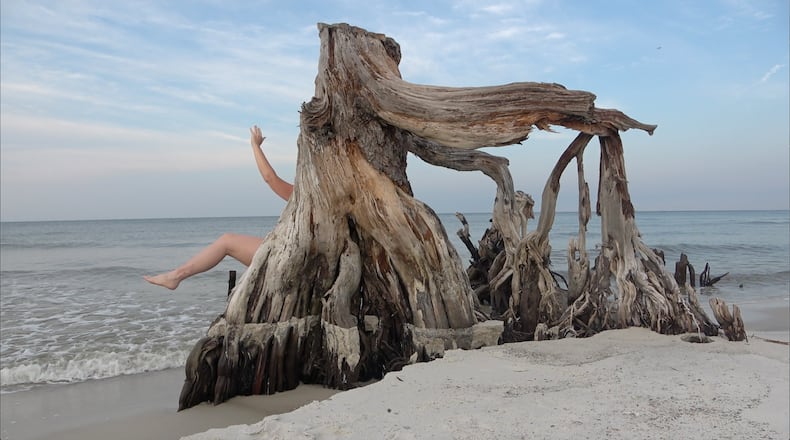An extraordinary number of shows this month fall under the category of “personal mythology” — turning details of artists’ lives into symbols that interact with the larger symbols of the society in which they live and were raised.
At Sandler Hudson Gallery through Jan. 6, Krista Clark’s “After Barkley” is a spectacular example of this, with elegant, architecturally influenced mixed-media works referring to the geometry of basketball courts. A series of equally elegant geometric works reference the shape of many Protestant and Catholic church windows, with texture provided by a thin layer of gray concrete.
Credit: Courtesy of Sandler Hudson Gallery
Credit: Courtesy of Sandler Hudson Gallery
The symbolism is condensed, and private. But similar experiences are shared by so many that they resonate far beyond Clark’s specific African-American circumstances. Pieces bridging the two experiences, notably Praying for Bank (You made, You made, my day), which incorporates a gospel-music vinyl record, provide interpretive keys, regardless of whether we know what doors they open. The art is potent.
Zipporah Camille Thompson’s “the ocean wept rainbows,” the Working Artists Project show at MOCA GA through Jan. 7, is as filled with objects and vivid color as the world of Clark’s art is spare and muted in its palette.
Credit: TWMeyer
Credit: TWMeyer
Thompson’s world has room for a socially committed environment of flash and glitter. It has a magical feel even when there is no literal magic involved. The assemblages combine elements as distinct from one another as digitally printed fabric and a repurposed automobile hood in frontier, or a chandelier chain and hair beads in deep and dreamy slumber.
These combinations serve a personal biographical vision, summed up in a poem that incorporates powerful symbols: Phrases such as “haint-like Carolina blue” provide a lovely synthesis of the names of an African American spiritually protective color and a secular regional one. The poem is a metaphoric guide to the complexity of the visual artworks and includes the example of her grandmother, “cultivating victory, hope, and love / radically transforming trauma into triumph.”
Elyse Defoor’s “Slivers of Time,” at Art Institute of Atlanta through Dec. 15, creates symbols from objects familiar to many women. Defoor uses them to interpret her own experience and that of a whole segment of society.
Beginning with symbolic garter belts, Defoor has mined the multiple meanings of different belts in the art (shown in photographs and in a stacked installation). Most recently she photographed household knives to explore the many meanings of “slit.”
In between, she has used wedding dresses (and statements from the women who wore them) and dresses as disguise or body armor (from daily life to moments of transition) to symbolize the complexity of her own experience, and that of many of other women.
Beyond that, her work has sought to find symbols or analogies for more transpersonal questions of family, birth and death, including violent death, although this last body of work isn’t included here. This succinct survey of the considerable range of Defoor’s oeuvre deserves attention for those perspectives alone.
Another condensation of a much more extensive body of work is Jaime Bull’s “The Stump Hole” at Day & Night Projects through Dec. 17. One of Bull’s unnervingly witty, voluminous soft sculptures of the female body is exhibited alongside two photographs of differently arranged figures that Bull filled with beach sand at one of the Florida Panhandle’s eroding beaches.
A bubbling champagne fountain casts dramatic shadows in the gallery, which is dominated by a video projection of the swimsuited artist striking semi-dramatic, semi-comic poses behind or in a large, sea-weathered tree stump at the water’s edge.
Again, private symbolism points in directions that nudge the viewer’s mind in multiple ways.
Since even inherited symbolism is shaped by personal circumstances, it’s interesting to bring this perspective to the annual Winter Wonderland at Fernbank Museum of Natural History through Jan. 6. Christmas trees, menorahs and Middle Eastern icons of the Virgin Mary were contributed by diplomats and representatives of the many national cultures whose citizens live in Atlanta.
Many of the trees have ornaments based on traditional arts, as interpreted by national artists invited to participate. The results are both educational and a genuine aesthetic experience.
Sandler Hudson Gallery, 739 Trabert Ave., Suite B, Atlanta. 404-817-3300, sandlerhudson.com.
MOCA GA, 75 Bennett St., Suite M1, Atlanta. 404-367-8700, mocaga.org.
The Art Institute of Atlanta, 100 Embassy Row NE, Atlanta. 800-275-4242, artinstitutes.edu/atlanta.
Day & Night Projects, 585 Wells St. SW, Atlanta. daynightprojects.art.
Fernbank Museum, 767 Clifton Road, Atlanta. 404-929-6300, fernbankmuseum.org.
Credit: ArtsATL
Credit: ArtsATL
MEET OUR PARTNER
ArtsATL (www.artsatl.org), is a nonprofit organization that plays a critical role in educating and informing audiences about metro Atlanta’s arts and culture. Founded in 2009, ArtsATL’s goal is to help build a sustainable arts community contributing to the economic and cultural health of the city.
If you have any questions about this partnership or others, please contact Senior Manager of Partnerships Nicole Williams at nicole.williams@ajc.com.
About the Author
Keep Reading
The Latest
Featured





